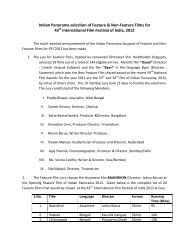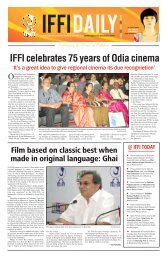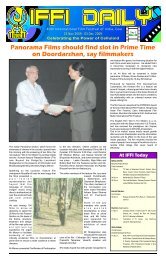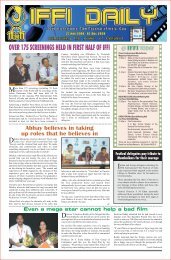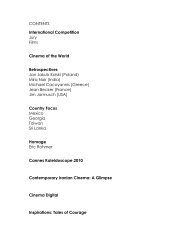Day 4 - International Film Festival of India
Day 4 - International Film Festival of India
Day 4 - International Film Festival of India
You also want an ePaper? Increase the reach of your titles
YUMPU automatically turns print PDFs into web optimized ePapers that Google loves.
6<br />
IFFIDAILY<br />
November 25, 2010<br />
Let platinum year be harbinger <strong>of</strong> Odia film industry’s revival<br />
Ashok PAlit<br />
IN 1934, a man from Puri, Mohan Sundar Dev Goswami mooted<br />
the idea <strong>of</strong> producing an Odia film. Back then, Odisha (then<br />
Orissa) lacked the basic infrastructural for film production — no<br />
director or a well-equipped studio was available. But Goswami prepared<br />
his own script based on a drama written by Kampal Mishra and<br />
teamed up with Priyanath Ganguli <strong>of</strong> Kolkata to produce first Oriya<br />
film ‘Sita Bibaha’ (Sita’s marriage). The film releases on April 28,<br />
1936, on occasion <strong>of</strong> Utkal Gourav Madhusudhan Jayanti at Laxmi<br />
Takies in Puri. ‘Sita Bibaha’ was the saga <strong>of</strong> a relentless struggle for<br />
a manifestation <strong>of</strong> Odia identity on celluloid. It is a trenchant reminder<br />
that Oriya film industry culminated from an undying determination<br />
<strong>of</strong> dreamers, who faced odds — at home and from outside.<br />
In spite <strong>of</strong> sincere efforts <strong>of</strong> Goswami, ‘Sita Bibaha’, a commercial<br />
failure, put the brake on the making <strong>of</strong> Odia films for the next 13<br />
years. No financier was ready to invest his money in another ‘disaster’.<br />
Then, Rupa Bharati, one <strong>of</strong> the first public limited companies in<br />
<strong>India</strong>, was formed in 1948 to provide a possible solution to the problem<br />
<strong>of</strong> finance. It collected shares worth Rs 10 to Rs 100 form people<br />
and decided to produced a film based on the legend associated with<br />
Lord Jagannath. Soon another film company Eastern Movietone<br />
came up, to beat Rupa Bharati. It produced ‘Lalita’ (1949), which too<br />
was based on Lord Jagannath. The following year, Rupa Bharati produced<br />
and released ‘Sri Jagannath’, which was about abolition <strong>of</strong> untouchability.<br />
This was the first Odia film to be remade in Telugu and<br />
was a big hit in south <strong>India</strong>.<br />
Fifties witnessed the advent <strong>of</strong> socio-mythological themes. The<br />
films made then include ‘Roll-28’, a love story directed by Kalyan<br />
Gupta, ‘Amari Gaan Jhia’, another love tale with dramatic twists-andturns;<br />
‘Kedar Gouri’, yet another sentimental love story ending on a<br />
tragic note; ‘Saptasajya’, a myth-based social drama, and ‘Bhai-Bhai’<br />
a story woven around ‘untouchability’ and ‘cast system’. The films <strong>of</strong><br />
the 50s were simply ‘photographed theaters with a lot <strong>of</strong> co-incidence<br />
in drama, <strong>of</strong>ten leading to melodrama. Sri Mahalaxmi Puja (1959)<br />
made by Krushna Chandra Tripathy Sharma <strong>of</strong> Aska, Ganjam at the<br />
fag end <strong>of</strong> fifties, was a commercial success. Once again the mythological<br />
film proved to be safer bets, and Sharma began to be regarded<br />
as the pioneer <strong>of</strong> the genre. He continued his lone efforts in making<br />
such films and went on to the dub few films from other language as<br />
well, like “Parinam (1960), Dashyu Ratnakar (1962) and Nari (1963).<br />
Between sixties and till the early seventies, only a couple <strong>of</strong><br />
films were produced. The sixties began with ‘Sri Lokanath’ which<br />
was critically acclaimed and a commercial success too. It was also<br />
the first Odia film to win a National Award, in 1960. The film had<br />
a fresh flavour. Based on the conflicting attitudes <strong>of</strong> two brothers<br />
— one an atheist and the other a theist, the wife <strong>of</strong> the elder brother<br />
acting as a catalyst for a compromise between the two. It’s rural<br />
FTII GOLDEN JUBILEE CELEBRATION<br />
Five student films to be screened today at Maquinez-I, begining from 12 noon<br />
Power <strong>of</strong> myths is that they go<br />
with all times: Elektra director<br />
“I want to explore themes that have endless validity…<br />
The story <strong>of</strong> Electra (a Greek mythological character) is<br />
several thousands <strong>of</strong> years old, but it is still relevant,”<br />
said Shyamaprasad, the director <strong>of</strong> the film ‘Elektra’.<br />
“The power <strong>of</strong> myths is that they go with all times,”<br />
he said.<br />
The film, which was screened at IFFI 2010 in the<br />
presence <strong>of</strong> its lead actress Manisha Koirala and<br />
Shyamaprasad, explores the texture <strong>of</strong> desire and loss.<br />
I have taken the same story <strong>of</strong> Electra into a household<br />
in Kerala in my film. I wanted to see how that work<br />
in a contemporary society in Kerala, the directors said.<br />
He said the highlight <strong>of</strong> his film is the performances<br />
by actress Nayantara and Manisha Koirala and actor<br />
Prakash Raj.<br />
He said it was unfortunate that people <strong>of</strong>ten relate<br />
Electra to ‘Electra complex’. “I think it’s a basic story<br />
within any family… it’s about the cycle <strong>of</strong> crime, revenge<br />
and punishment,” he said.<br />
Elektra is Shyamaprasad’s fifth film at IFFI. His earlier<br />
film, Ore Kadal, based on Bengali novel by Sunil<br />
Gangopadhyay, enjoyed the honor <strong>of</strong> being the inaugural<br />
film <strong>of</strong> the <strong>India</strong>n Panorama at the IFFI in 2007.<br />
A still from Nirad Mahapatra’s National Award winning film Maya Miriga<br />
PLATINUM JUBILEE OF ODIA CINEMA<br />
Inauguration today at 3 pm at Maquinez I<br />
**KRAMASHA<br />
(2007)<br />
Dir: Amit Dutta/<br />
22min<br />
Manisha Koirala at IFFI on Wednesday<br />
Docs & shorts<br />
by ramesh tekwani<br />
milieu was quite convincing.<br />
The Odia cinema’s glorious time, in terms <strong>of</strong> quality, came between<br />
1960 and 1970. During the period, a number <strong>of</strong> Odia films<br />
were made on book by popular novelist like Kanhu Charan Mohanty<br />
(‘Kaa, Abhinatri’), Basanti Kumari Pattnaik (‘Amadabata’) Upendra<br />
Kishore Das (‘Mala Janha’) and Kalandi Charan Panigrahi (‘Matira<br />
Manisha’) to name a few. The film’s themes then centered around<br />
the ideal women encountering various social and psychological conflicts,<br />
ultimately emerging gloriously from all vicissitudes <strong>of</strong> life. The<br />
female protagonists in ‘Sadhana’ and ‘Bhai Bhauja’ upheld the traditional<br />
values and through tolerance and patience, overcome their<br />
problems. During the entire sixties, two outstanding film were made,<br />
they were ‘Nitai Palit’s Malajanha’ and Mrinal Sen’s ‘Matira Manisha’.<br />
Commercially both the film did not do well but showed a definite<br />
attitude in Odia cinema.<br />
Major stars <strong>of</strong> fifties and sixties include Gour Prasad, Sarat Pujari,<br />
Ratikanta and Pramod Gloria, Chapala, Shanti Sudha, Sukhalata, Jharana,<br />
Geeta and Minati. Later, during the seventies and eighties, Prasanta<br />
Nanda, Sriram Panda, Uttam Mohanty, Bijaya Mohanty, Ajit<br />
Das, Tripura Misra, Banaja, Sujata, Malabika, Mahasweta, Deepa<br />
Sahu, Niharika, Anita, Subhra Pati, Baisali, Aparajita, etc., appeared<br />
in the leading roles.<br />
From eighties to nineties, Miher Das, Sidhanta, Rachana Banarjee<br />
ruled the industries. After Mahaswata and Prasanta Nanda,<br />
Uttam and Aparajita, Sidhanta-Rachana, they acted in maximum<br />
number <strong>of</strong> Odia films.<br />
During the seveties, especially after the runway hit, ‘Mamata’<br />
(1975) directed by Bymokesh Tripathy <strong>of</strong> Anapurna Theater, there<br />
was a sudden rise in film production costs. Though a number <strong>of</strong> Odia<br />
films were produced, no attempt was made to provide the basic<br />
amenities to the producers in the state. To overcome the same and to<br />
encourage Odia films, the Orissa <strong>Film</strong> Development Corporation Ltd.<br />
was established in 1976.<br />
The first colour Odia film, “Gapa Helevi Sata”, was made in 1976,<br />
though a partially colour film, ‘Samaya’, had been made a year before.<br />
During the mid seventies, Oriya cinema lost its direction, films<br />
were made with the sole intension <strong>of</strong> doubling the investments, irrespective<br />
<strong>of</strong> quality. During the eighties, a total <strong>of</strong> 119 films were produced;<br />
maximum, 17 films, in 1986.<br />
However, most important event <strong>of</strong> the Oriya film industry happened<br />
in the eighties with the arrival <strong>of</strong> three directors <strong>of</strong> the “Parallel”<br />
cinema”: Nirad Mohapatra, Manmohan Mohapatra and Sagir<br />
Ahamed. All from <strong>Film</strong> and Television Institute <strong>of</strong> <strong>India</strong>, Pune, they<br />
brought glory to the film industry. Nirad Mohapatra’s ‘Maya Miriga’<br />
(1984) is a milestone in the history <strong>of</strong> Odia Cinema. It is the only<br />
second Odia film to have won National Award for Best <strong>Film</strong>. Shagir<br />
Ahamed ‘Dhare Allua’ was selected to <strong>India</strong>n Panorama in 1984<br />
along with ‘Maya Miriga’. On the other hand Manmohan Mohapatra<br />
laid the foundation <strong>of</strong> new wave cinema in Odisha in 1982, with his<br />
first film ‘Seeta Rati’, which was included in IFFI’s <strong>India</strong>n Panorama<br />
in 1982. Other notable directors are A.K. Bir, Shantanu Mishra, Biplab<br />
Roy Choudhury, Pranab Das, Sushanta Mishra, Subash Das,<br />
Bijoy Ketan Mishra, Prafulla Mohanty, Chakradhar Sahu, Sabyasachi<br />
Mohapatra and Dolly Jena.<br />
By 1990, the film industry was hit by the TV boom and faced a<br />
threat from threat from mega-budget Hindi films. Number <strong>of</strong> theaters<br />
did not improve, major banners were disillusioned about the<br />
type <strong>of</strong> film to make. Some entered the small screen. Audience refuse<br />
to see the same faces in every film. Since 2000 to till date,<br />
Odia film production has increased. But most <strong>of</strong> the film were a remake<br />
<strong>of</strong> Hindi, Telgu or Bengali films. Yet, it is heartening to note<br />
that many new talents from the film institute are coming forward<br />
to take up assignments in Odia films. The industry needs support<br />
from all sections <strong>of</strong> the society to prevent it from withering away.<br />
Let the platinum year be the harbinger <strong>of</strong> its revival.<br />
The writer is a journalist and film writer based in Odisha.<br />
What do you need the most<br />
to make a film? Passion<br />
N Vidyasagar and Manoj Srivastav at the discussion<br />
I HAD always thought that something needed to<br />
happen to provide inspiration to a documentary<br />
or short filmmaker to get going. Today, I discovered<br />
that passion, alone, is enough to get a film<br />
made; and that is what got Ramprasad Adpaikar<br />
going. He started with wanting to make a film.<br />
Then, he went on to create a premise. A story developed<br />
around this, a script written and shot.<br />
The result, a film called Sin. An experimental<br />
film that is, both, interesting to watch and discuss,<br />
post viewing.<br />
A picture may be worth a thousand words;<br />
but, a few well chosen words woven into a story<br />
can add value that is multiplied multi-fold. That<br />
is what Chaitanya Tahane discovered when he<br />
went out to check out the tea tasters at Darjeeling.<br />
As the buyer takes a sip, especially a big<br />
international one, he is given a colourful account<br />
<strong>of</strong> the origin <strong>of</strong> the tea that he is sipping<br />
so carefully : that the leaves are plucked at night<br />
under a full moon by chosen virgins… the story<br />
is built up layer by layer and as the buyer laps<br />
up the story, the price <strong>of</strong> the tea gets enhanced.<br />
Sometimes going up to fifty thousand rupees<br />
and more per kilo. The buyer may or may not<br />
have been convinced; but Chaitanya sure was!<br />
He just had to put this on film. An ordinary expose<br />
was too passé for this young filmmaker.<br />
He took the real and fictionalised it in Six<br />
Strands. How he shot the film makes a good<br />
subject for yet another film.<br />
Surjo Deb’s Twisted Bitter delved into creativity<br />
and plagiarism. A story based on a story<br />
and its aftermath. Leading on to a discussion <strong>of</strong><br />
ethics and choices before filmmakers. Deb may<br />
have made a film that had plagiarism in its underlying<br />
layers but he, together with his colleagues<br />
on the dais and the audience were all <strong>of</strong><br />
one opinion. Ban plagiarism.<br />
Well placed righteousness apart, the audience<br />
that met these directors was curious to know<br />
how these films got made and that how could<br />
they be monetised. Saameer Mody <strong>of</strong> 1TakeMedia<br />
provided a part solution. The 1 Take Media<br />
Channel on the internet. If you have a short film,<br />
then 1TakeMedia will take it up on a non-exclusive<br />
revenue sharing basis. The returns depending<br />
upon the clicks your film generates gets you<br />
the money. There is nothing that works as effectively<br />
as viral. Talk to Saameer, if you have a<br />
film for him. He has an international audience<br />
waiting for you just a click away.<br />
The day ended with a message from the CEO<br />
<strong>of</strong> ESG, Manoj Srivastav. He played an incomparable<br />
duet with N Vidyasagar <strong>of</strong> Pickle Magazine.<br />
The pipers were telling the audience how<br />
they could shoot in Goa at a whole lot <strong>of</strong> interesting,<br />
exotic, traditional, historic, sunny, watery,<br />
breezy, staid, unique and once in a life time locations<br />
and take back some money after all that. So,<br />
when are you coming back to shoot in Goa?<br />
The writer is a director and producer <strong>of</strong> short films and<br />
has been moderating discussion sessions at the Short <strong>Film</strong><br />
Center.<br />
Edited by: Shambhu Sahu on behalf <strong>of</strong> Directorate <strong>of</strong> <strong>Film</strong> <strong>Festival</strong>s, Ministry <strong>of</strong> Information & Broadcasting, New Delhi<br />
Hindi Editor: Mukesh Kaushik<br />
Printed at: Herald Publication Pvt. Ltd. Verna, Goa





